<<PREVIOUS -
HOME -
CONTENTS -
NEXT>>
DOUBLE STARS INDEX -
![]()
<<PREVIOUS -
HOME -
CONTENTS -
NEXT>>
DOUBLE STARS INDEX -
![]()
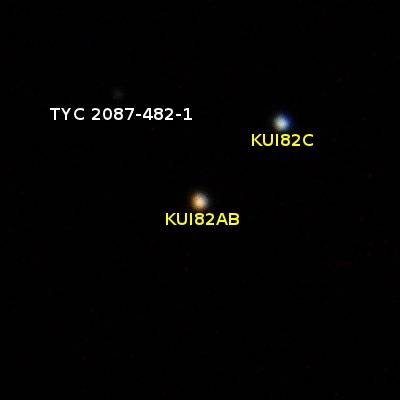 |
Double stars KUI82AB,C image 5970 taken by Tom Frey and processed by David Haworth
Introduction
Researching double stars that have been observed and measured is brain candy to providing insight to the universe. Above is is an image of KUIAB,C taken by Tom Frey with an alt-azimuth Dob and DSLR without a field rotator. The image 5790 is the best image of five images taken. The above image was processed from the Canon raw image 5970.CR2 by David Haworth. Image processing included converting the Canon raw CR2 file to a PNG file with GIMP V2.8.2. The PNG file was cropped around KUI82AB and rotated so that north is at the top. East is at the left edge of the image. Star TYC 2087-482-1 is very dim and is just above the first 8 in the label. KUI28AB color is red indicating it is a cool later spectral type star and KUI82C color is a blue star indicating is a hot early spectral type star.
Below show how to research KUI82AB,C from the Washington Double Star Catalog, VizierR Search, Aladin sky atlas and SDSS.
Washington Double Star Catalog
Washington Double Star Catalog (WDS) is a good starting point for on-line source of double star information and data. Search the Washington Double Star Catalog by RA and Dec. KUI82AB,C is WDS identifier 17293+2924 with discover KUI. The components indicate there are three stars being labeled A, B and C. The brightest star is labeled A. The next closest star is labeled B and the farest star is labeled C.
The number of double star measurements for KUIAB,C is 27. The first and last observation data is provided. KUI82AB,C first observation date is 1883 and the last observation date is 2010. Double star position angle theta changed from 271 degrees to 313 degrees and rho changed 59.5 arcseconds to 49.8 arcseconds between these two observation dates. The position angle theta are unprecessed.
The position of the north celestial pole changes over time because of the earth's precession. The change of the north celestial pole over time affects the position angle theta values since theta is referenced to the north celestial pole. In other words, the double star position angle theta changes over time because of the change in the north celestial pole position.
The proper motion of KUIAB (-189 arcseconds RA, -278 arcseconds Dec) is over 20 times the proper motion of KUI82C (-009 arcseconds RA, -278 arcseconds Dec). Most likely KUI82AB and KUI82C are optical doubles due to the line-of-sight coincidence and they are not binary stars orbiting each other because of this large proper motion difference between stars KUIAB and the star KUI82C. The proper motion time unit is 1000 years.

Click on the table to go to the Washington Double Star Catalog
The WDS notes file contains additional information on 17293+2924 KUI82AB,C as shown below. The Kiy2008 confirmed that KUIAB,C are an optical pair.

Click on the table to go to the Washington Double Star Catalog notes file
Kiy2008 Reference
Using
SAO/NASA Astrophysics Data System
we can find that Kiy2008 reference is dynamical study of wide pairs of stars based on data from the WDS catalog by Kiyaeva O.V., Kiselev A.A., Izmailov I.S.
2008AstL...34..405K.
Unfortunately the paper is only available by purchasing it.
Washington Double Star Catalog VizieR Search Page
17293+2924 in the Washington Double Star Catalog VizieR search page shows the details on KUI82AB,C. VizieR shows that KUI is the discoverer code for Gerard Peter Kuiper
CDS catalog J/PAZh/34/446 Dynamical study of wide pairs of stars from WDS (Kiyaeva+, 2008). In optical binaries (396 rows) KUI 82 AB-C is record number 255 as shown below.
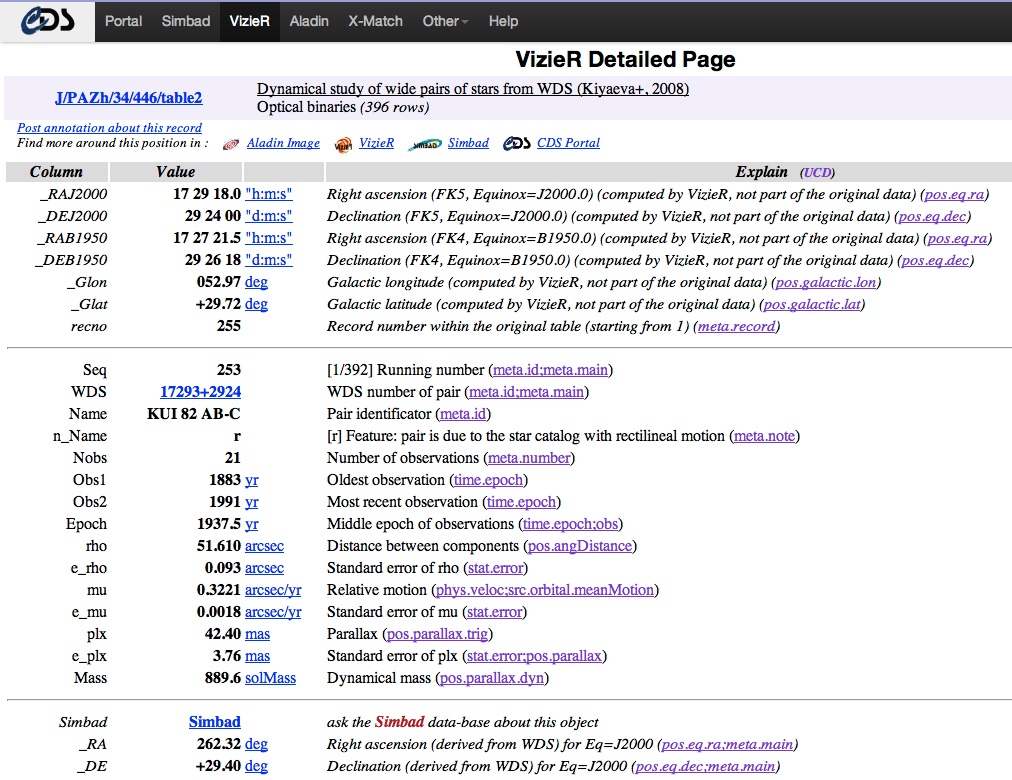
Click on the table to go to the VizierR Detailed Page
KUI82AB
KUI82AB is discover code A 351 for Robert Grant Aitken.
A 351 AB are very close double stars with a separation of less than ~0.6 arcseconds and they have similar proper motion making them binary stars.

Click on the table to go to the VizierR Detailed Page
Aladin Sky Atlas of KUI 82 AB,C with Proper Motion Vectors
The below plot shows red arrows that are the stars proper motion. The red KUI 82 AB stars proper motion are very similar. The blue KUI 82 C star's proper motion is much smaller than the proper motion of KUI 82 AB stars.
Notice, the KUI 82 AB second star is missing from the red circle. If the red circles are in the correct location on the Aladin sky atlas then there is a good possibility that KUI 82 AB is not a double star but it is the same star with two slightly different RAs, Decs and proper motions measurements. Further down this web page SDSS and 2MASS images will be shown with the missing KUI 82 B star.
Click on the below screen capture to load Aladin sky atlas. It will take awhile to load the Aladin.jar on your computer. You may get a security warning about running Aladin.jar. After it loads, click on Optical in the top left corner to view the DSS (Digitized Sky Survey) color image as shown below. The DSS color image shows the KUI 82 AB red color and the KUI 82 C blue color that confirms our image 5970 is of the correct double stars. Using Aladin the faint star above and to the left of KUI 82 AB was identified as TYC 2087-482-1.
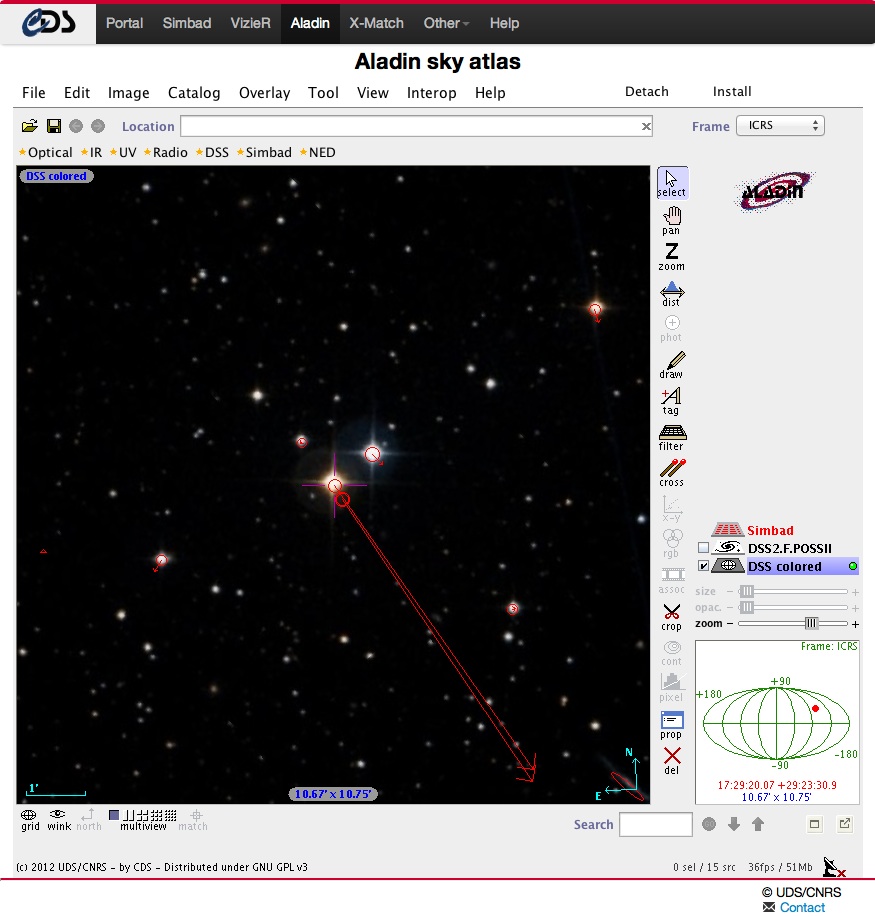
DR10 Navi Tool for SDSS Image
A 351 VizieR result page provides information on A 351 in various catalogs. For example, towards the bottom of this web page is the reference of SDSS and Johnson-Cousins photometry of F-K stars (Just+, 2008). A 351 has a RA of 262.333638 and Dec of +29.391926 and this is entered in SDSS DR10 Navi tool and the below color image is shown. There is no indication of a double star in the SDSS image.

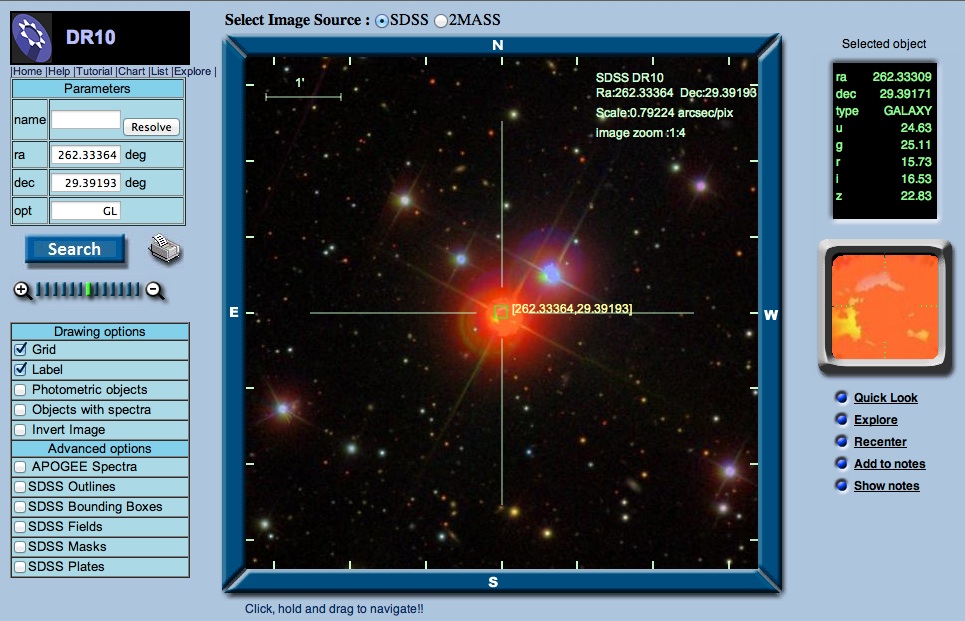
DR10 Navi Tool for 2MASS Image
A 351 has a RA of 262.333638 and Dec of +29.391926 and this is entered in SDSS DR10 Navi tool and 2MASS image source is selected. The below 2MASS image in the near-infrared spectrum (J 1.24 um, H 1.65 um and K 2.16 um bands) is shown with no indication of a close double star A 351 in the 2MASS (Two Micron All Sky Survey) image.
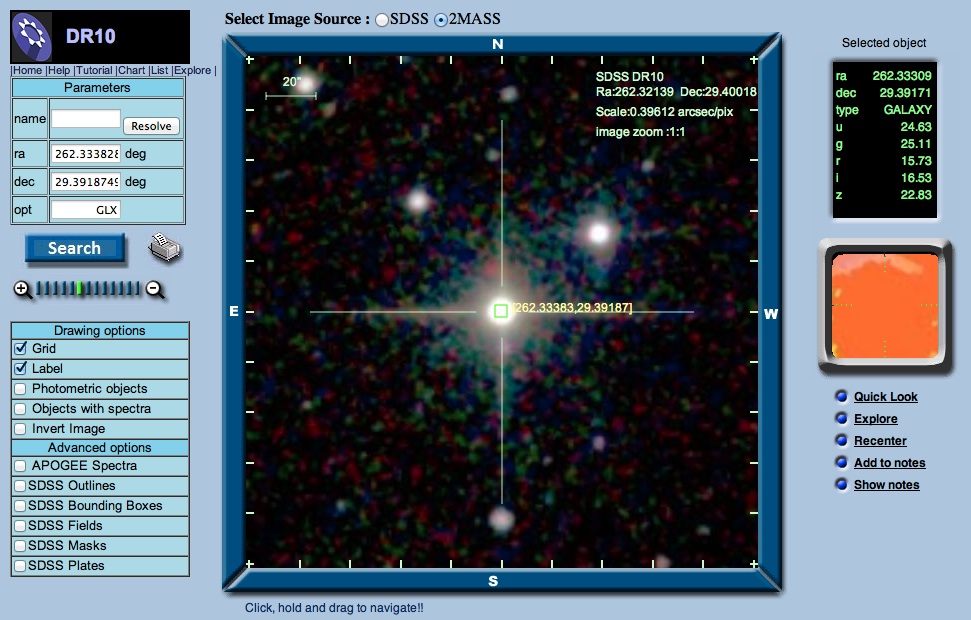
KUI 82 AB,C Summary
KUI 82 AB is A 351 that does not show as a double star on DSS, SDSS and 2MASS images.
KUI 82 C proper motion does not support that it is part of KUI 82 AB and that KUI 82 C is an optical double.
KUI 82 AB,C form a colorful optical double with KUI 82 AB color being red and KUI 82 C color being blue.
Links ![]()
References
|
|

Thomas G. Frey Thomas G. Frey is Professor Emeritus of Chemistry at California Polytechnic State University, San Luis Obispo, CA. He has been an active member of the Central Coast Astronomical Society for over 25 years. He was a team leader at the Pine Mountain Observatory (PMO) Summer Science Research Work- shop, Bend, OR, 2009 and co-director of the PMO workshop, summer of 2011. |
|
|
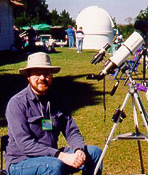
David Haworth enjoys astronomy imaging and processing those images to bring out details that cannot be seen easily by visual observing with the same size optics. David Haworth started astroimaging with a Cookbook CCD camera he built in 1996 and since then has used many types of cameras to image the sky. David wrote Chapter 2: "Afocal Photography with Digital Cameras" in the second edition of "The Art and Science of CCD Astronomy" which was published in December 2005. David's images have appeared in magazine front covers, articles, books, catalogs, videos, music CD covers, T-shirts, other web sites, etc. |